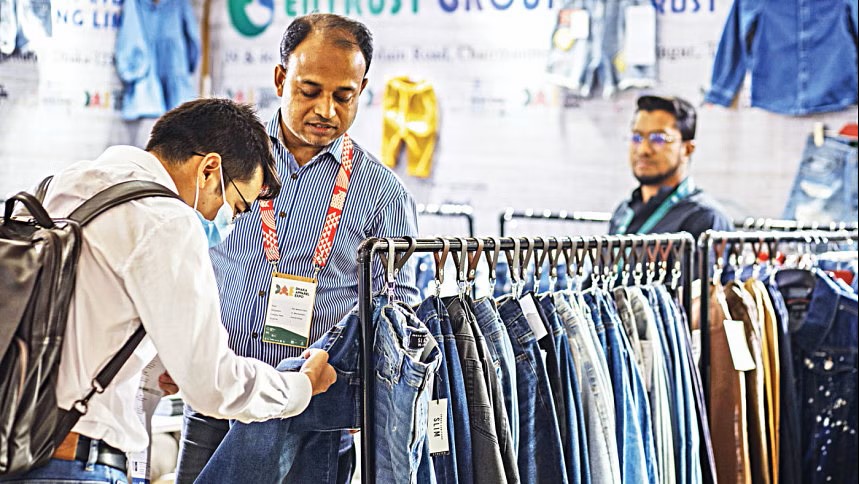About 68 per cent of Bangladesh’s annual export earnings from apparels is still confined to just 10 items, indicating that product diversification in the industry is yet to reach expected levels even after a journey of four-and-a-half decades.
The 10 most exported apparel items accounted for $30.94 billion of the country’s $45.70 billion earnings from the industry last year, according to data from the Export Promotion Bureau compiled by the Bangladesh Garment Manufacturers and Exporters Association (BGMEA).
As always, knitted cotton T-shirts saw the highest exports in 2022, registering earnings of $8.93 billion with roughly 26 per cent year-on-year growth.
This means that T-shirts contributed some 20 per cent of the total apparel exports that year, when Bangladesh captured 23 per cent of global trade in the sector, the data shows.
The 10 most exported apparel items accounted for $30.94 billion of the country’s $45.70 billion earnings from the industry last year
Men’s woven trousers were the second highest earner, registering about 23 per cent year-on-year growth to hit $5.94 billion with a 13 per cent share of the total apparel exports. Locally made men’s trousers, including child sizes, hold a 21 per cent stake in the global market.
Women’s trousers were the third largest export item, earning $3.63 billon with year-on-year growth of 19.10 per cent. The sector has a global market share of around 16 per cent.
Meanwhile, cotton jerseys and pullovers placed fourth in terms of earnings while those made of manmade fibre stood at fifth.
Men’s cotton woven came next at sixth, women’s cotton knitted trousers seventh, synthetic woven trousers eighth, men’s cotton knitted shirts ninth and men’s cotton knitted trousers was the tenth most exported apparel item in 2022.
Bangladesh’s share in the global market for these 10 items was about 15 per cent of the $160.43 billion registered that year. At the same time, the country grabbed an 8 per cent share of the overall global apparel market valued at $431.94 billion.
Among these top 10 garment items, only 12 per cent of the export earnings in 2022 came from non-cotton apparels while cotton-based apparels made up the rest, said BGMEA President Faruque Hassan.

“Although we have experience and a good capacity for producing cotton-based apparels, we are still lagging behind in the non-cotton sector,” he added.
Hassan went on to say that while only 25 per cent of the textiles consumed worldwide are made of cotton, 75 per cent of Bangladesh’s garment industry is concentrated on making cotton clothes.
“So, huge opportunities await but we have a capacity shortage when it comes to making high-end garments such as sportswear, lingerie and outerwear,” he said.
“To increase Bangladesh’s hold on the global non-cotton apparel market, we need to increase efficiency and technical know-how in the industry,” the BGMEA chief added.
Hassan then said more investments are needed in backward linkage industries while the environmental aspect of industrial production should be kept in mind.
During the first two months of 2023, garment exports from Bangladesh grew by some 10 per cent year-on-year.
A significant part of the growth was contributed by shipments to the European Union (EU), the largest export destination for Bangladesh.
Exports to the EU amounted to $4.22 billion during the January-February period, registering year-on-year growth of 8 per cent.
However, Bangladesh saw negative growth in exports to eight of the 27 countries in the EU, namely Germany, Austria, Bulgaria, Denmark, Finland, Latvia, Malta, Poland and Slovenia, the data says.
During the two-month period, exports to Germany fell 12.37 per cent to $1.17 billion. On the other hand, shipments to France and Spain grew by 14 per cent and 22 per cent to $477.87 million and $645.68 million respectively.
At the same time, exports to the US fell roughly 14 per cent to $1.33 billion from $1.54 billion. Shipments to Canada also dropped by some 3 per cent to reach $206.80 million.
However, exports to the UK saw 21.63 per cent year on-year growth to stand at $964 million during the first two months of the current calendar year.
Bangladesh’s exports to non-traditional markets rose remarkably in the January-February period, showing year-on-year growth of 42.51 per cent to hit $1.64 billion from $1.15 billion.
Currently, the share of export earnings from clothing sent to non-traditional markets stands at 19.64 per cent. Japan is the top destination among major non-traditional markets, fetching $321.12 million during the period.
Exports to other non-traditional markets such as Australia, India, South Korea, Turkey and the UAE are also rising but shipments to Russia, China, South Africa and Chile have declined, the data shows.
















